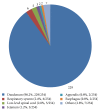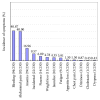Duodenal Rare Neuroendocrine Tumor: Clinicopathological Characteristics of Patients with Gangliocytic Paraganglioma
- PMID: 28096810
- PMCID: PMC5209618
- DOI: 10.1155/2016/5257312
Duodenal Rare Neuroendocrine Tumor: Clinicopathological Characteristics of Patients with Gangliocytic Paraganglioma
Abstract
Gangliocytic paraganglioma (GP) has been regarded as a rare benign tumor that commonly arises from the second part of the duodenum. As GP does not exhibit either prominent mitotic activity or Ki-67 immunoreactivity, it is often misdiagnosed as neuroendocrine tumor (NET) G1. However, the prognosis might be better in patients with GP than in those with NET G1. Therefore, it is important to differentiate GP from NET G1. Moreover, our previous study indicated that GP accounts for a substantial, constant percentage of duodenal NETs. In the present article, we describe up-to-date data on the clinicopathological characteristics of GP and on the immunohistochemical findings that can help differentiate GP from NET G1, as largely revealed in our new and larger literature survey and recent multi-institutional retrospective study. Furthermore, we would like to refer to differential diagnosis and clinical management of this tumor and provide intriguing information about the risk factors for lymph node metastasis on GP.
Conflict of interest statement
The authors declare that there are no competing interests regarding the publication of this paper.
Figures



References
Publication types
LinkOut - more resources
Full Text Sources
Other Literature Sources
Research Materials

